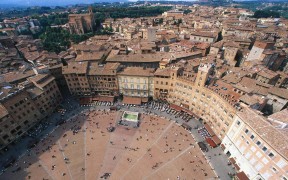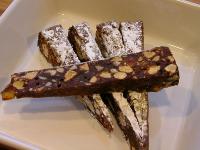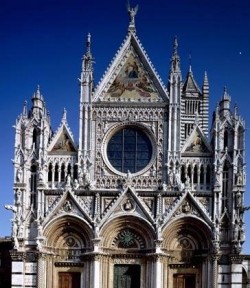 Deep in the heart of rural Tuscany, lies the quaint, medieval town of Siena. Often overlooked because of its imposing neighbour, Florence. Siena is a quintessentially, a Tuscan walled town.
Deep in the heart of rural Tuscany, lies the quaint, medieval town of Siena. Often overlooked because of its imposing neighbour, Florence. Siena is a quintessentially, a Tuscan walled town.
The heart of the city is the Piazza del Campo, the main square, where the Sienese used to hold their markets and sporting events in medieval times, and is now the hub of Sienese social life. Paved with red bricks, the Piazza is in the shape of a concave bowl. Flanked by the civic buildings on one side and the ceremonial fountain at the other, the edges are ringed by cafés, restaurants and souvenir shops.
 Grab a slice of Panforte the traditional cake, made with nuts, fruits and spices, perhaps with a glass of Chianti, and join the hordes of people sitting on the sun-baked floor of the Piazza and watch the world go by.
Grab a slice of Panforte the traditional cake, made with nuts, fruits and spices, perhaps with a glass of Chianti, and join the hordes of people sitting on the sun-baked floor of the Piazza and watch the world go by.
Two hours of walking will take you around the city and back. The tight, narrow streets, curving in and around medieval doorways and buildings, all seem to lead back into the Piazza del campo. A visit to the Duoma, Siena’s 12th Century cathedral and a great example of Italian Romanesque architecture, is also a must.
 The town comes into its own twice a year, when the Palio or horse race is held in the Piazza del Campo. Contested by 17 contrado or city neighbourhoods, they vie for a flag bearing the image of the Virgin Mary. Drawing in hordes of people from all over Europe, the Palio, is a matter of great pride for the people of Siena.
The town comes into its own twice a year, when the Palio or horse race is held in the Piazza del Campo. Contested by 17 contrado or city neighbourhoods, they vie for a flag bearing the image of the Virgin Mary. Drawing in hordes of people from all over Europe, the Palio, is a matter of great pride for the people of Siena.
Most people consider Siena worthy of just a day-trip from that hub of Italian art – Florence. But it definitely deserves more. Siena offers a chance to experience the justifiably famous Tuscan cooking, wines and medieval city life, with far fewer tourists and in an immaculately preserved culture, architecture and a special flavour of its own that lingers long after you have left its cobbled streets.





